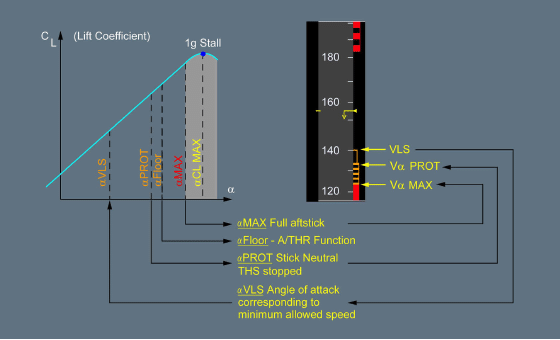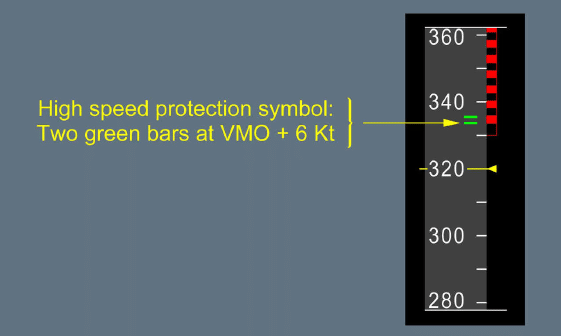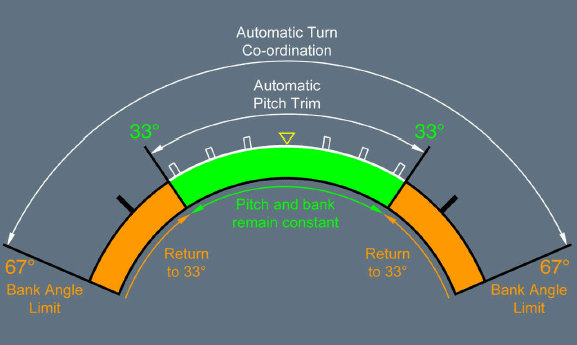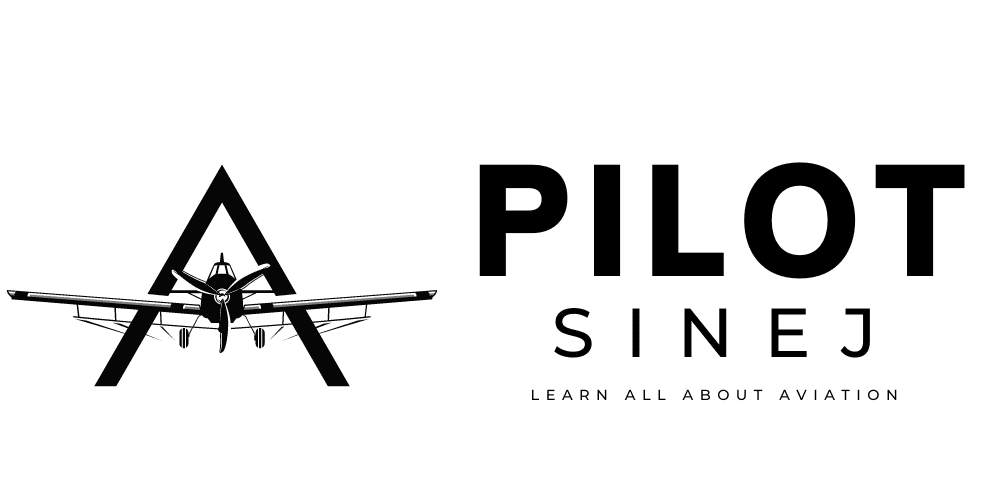The Airbus A320 flight control system is built on a fly-by-wire philosophy, where computer-mediated laws govern how pilot inputs are translated into aircraft responses. At the core of this system is “Normal Law“—the standard flight control mode that ensures safe, smooth, and predictable handling under normal conditions. This article explores what Normal Law is, how it works, and the protections it offers pilots throughout each phase of flight.
What Is Normal Law in the Airbus A320
Normal Law is the default flight control mode in the A320 during all phases of flight except when degraded to Alternate or Direct Law due to failures. It manages pitch, roll, and yaw through side-stick inputs and coordinates these inputs with full flight envelope protections and maneuver load alleviation. Normal Law is active from takeoff until 100 feet above ground during landing, offering the highest level of automation and safety logic.

How Pitch Control Works in Normal Law
Ground Mode – Direct Sidestick-to-Elevator Relationship
On the ground, sidestick deflection directly commands elevator movement. There’s no auto-trim, and the THS (Trimmable Horizontal Stabilizer) is set to 0° by default unless manually adjusted for center of gravity. During the takeoff roll, maximum elevator authority is limited to reduce the risk of abrupt rotation.
Flight Mode – Load Factor Demand and 1g Stability
In flight, the pitch control law is based on load factor demand. The aircraft automatically trims to maintain 1g flight when the sidestick is neutral. Pilots don’t need to manually adjust trim, even during configuration or speed changes. The system interprets stick input as a command for a certain g-load rather than a pitch attitude.
Flare Mode – Manual Flare with THS Freeze
Below 50 feet RA, the system enters flare mode. It memorizes the pitch attitude at 50 feet and gradually reduces it to a 2° nose-down attitude over 8 seconds. The THS is frozen, and the pilot must apply a gentle nose-up input to perform the landing flare.
Understanding the Built-In Protections of Normal Law
Load Factor Limits for Structural Safety
The system limits the aircraft’s g-load to +2.5g to -1g in clean configuration and +2g to 0g in other configurations. This allows pilots to make full-stick inputs in emergencies without risking structural damage. The system is designed for instinctive reactions under stress, providing instant and safe maneuvering capability.

Pitch Attitude Limits to Prevent Energy Mismanagement
Pitch attitude is limited to 30° nose-up (Conf 0-3), 25° (Conf FULL), and 15° nose-down. These limits protect against rapid energy loss or gain and are adjusted downward at low speeds. FD bars disappear beyond ±25° pitch and reappear within safe pitch zones.
High Angle of Attack Protection Against Stall
When the angle of attack exceeds αPROT, the system switches to AOA demand mode. The aircraft maintains AoA at αPROT unless the pilot continues pulling aft, in which case AoA increases toward αMAX. Trim is frozen in this mode. Even at full aft sidestick, the aircraft won’t stall. If the sidestick is released, AoA returns to αPROT. This protection works even during turns or gusts.

Overspeed Prevention with High Speed Protection
Activated at or above VMO/MMO, this protection limits nose-down authority and commands a nose-up pitch to recover. THS movement is constrained, and bank angle is limited to 40°. Spiral stability shifts to 0°, and the autopilot disconnects at VMO + 15 kt or MMO + 0.04.

Bank Angle Protection and Roll Behavior
Up to 33°, the aircraft maintains roll attitude when the stick is neutral. Beyond that, spiral stability returns the aircraft to 33° bank. With full lateral stick, the aircraft rolls to 67° maximum, unless in AOA or high-speed protection, which limit bank to 45° and 40° respectively. Autotrim is inhibited beyond 33° bank, and FD bars disappear if bank exceeds 45°.

How Lateral Control Works in Normal Law
Sidestick Roll Rate Command Logic
The sidestick commands roll rate, not roll angle. Full stick deflection results in a roll rate of up to 15° per second. The system combines ailerons and spoilers (except Spoiler #1) to achieve this, adjusting surface deflection based on speed.
Rudder Coordination and Dutch Roll Damping
Normal Law automatically provides turn coordination and Dutch roll damping. The rudder is used by the system as needed, so the pilot does not need to apply rudder during turns in normal conditions. Transitions between ground, flight, and flare modes are smooth and automated.
Managing Engine-Out Scenarios with Sideslip Guidance
Visual Rudder Guidance Using the Blue Slip Indicator
In engine-out conditions, especially during takeoff or go-around, the sideslip index on the PFD turns blue. This provides a visual cue for the pilot to apply rudder and optimize climb performance. The system minimizes sideslip and indicates the proper correction instinctively.

Autopilot Behavior and Manual Override in Normal Law
Autopilot Disengagement Triggers
Autopilot disconnects if the pilot overrides it by applying force to the sidestick, using the rudder pedals (10° out of trim), or turning the trim wheel beyond a limit. Even with autopilot engaged, most protections remain active—except for pitch attitude protection.
Transition to Flare and THS Freeze Zones
As the aircraft descends below 50 feet RA, the system freezes THS and enters flare mode. Below 30 feet, it begins reducing pitch to encourage pilot-controlled flare. The transition is smooth, with pitch rate damping and memory of the 50 ft reference pitch attitude.
How Normal Law Enhances Flight Safety
Normal Law ensures that the A320 remains within safe flight parameters while reducing pilot workload. Its protections prevent overstress, stalls, and excessive pitch or speed excursions. The system allows instinctive pilot actions in emergencies, which can be critical for obstacle clearance or upset recovery. It’s a cornerstone of Airbus’ fly-by-wire philosophy.
(Video) A320 Normal Law
Conclusion
The Airbus A320’s Normal Law integrates advanced protections, intuitive handling, and automation to ensure safe and efficient operation in all normal phases of flight. Understanding its modes, transitions, and built-in limits is essential for every A320 pilot. In future discussions, we’ll explore Alternate and Direct Law to see how the system behaves when Normal Law is unavailable.
Frequently Asked Questions About A320 Normal Law Protections
What protections are included in Airbus A320 Normal Law?
- Load Factor Protection – prevents structural overstress by limiting g-loads
- Pitch Attitude Protection – limits excessive nose-up or nose-down pitch
- High Angle of Attack (AOA) Protection – prevents stalls by limiting maximum AoA
- High Speed Protection – reduces nose-down authority and commands nose-up pitch above VMO/MMO
- Bank Angle Protection – limits roll angle and maintains spiral stability
How does high angle of attack protection work in the A320?
What is the function of load factor protection in Airbus Normal Law?
When is pitch attitude protection active and what are the limits?
How does high speed protection prevent overspeed in the A320?

